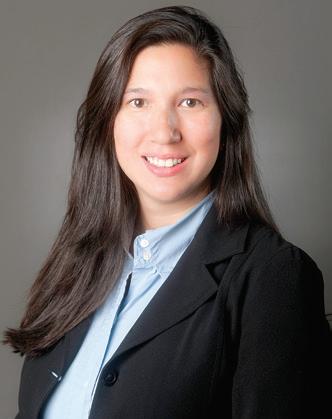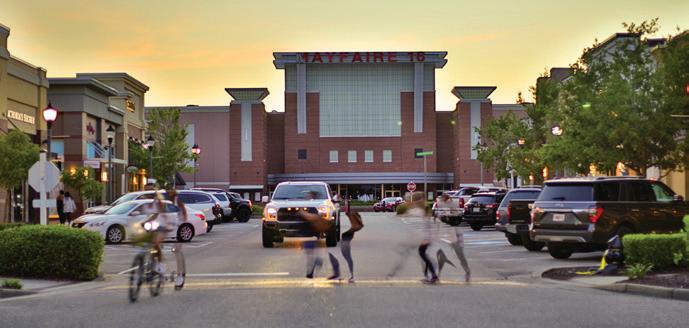
9 minute read
SOUND OFF
ONE STEP CLOSER TO BETTER
AS I INDULGE IN WEEKENDS OF FOOTBALL ES-
CAPISM, I CAN’T HELP
BUT RECOGNIZE THAT
THE GEICO COMMER-
CIALS ABOUT BECOMING
YOUR PARENTS ARE ALL
TOO TRUE.
Many of us find ourselves bemoaning the present and fondly remembering yesteryears, never mind the fact that it’s not true.
“The country is divided …, China is going to take all our jobs …, the youth of today think they know everything, and they don’t even know what good music is …”
We heard all these concerns growing up too, except the words came out of someone else’s mouth, and it was Japan that was going to steal our jobs.
On average, the world is a better place today than ever before. We just need to slow down and appreciate that while better today, the best is yet to come.
Yes, the current pandemic is causing stresses, but imagine the pandemic without the internet and modern medicine.
The growth in living standards is a lot like the growth of children; each day looks awfully similar to the previous, but stop looking for a few years, and the world won’t even be recognizable. Vehicles are a great example of this incremental process over time, “Does that have a CD player in it?” was a question asked in
A D A M JONES
awe during the early 1990s and is now asked as a form of derision.
The obsoleting of the CD player is but one example of a world vastly improved from the past where one had to remember telephone numbers, put a key in the car or, heaven forbid, actually light the fireplace using a match.
While these examples are superficial, there are many other ways in which the world has improved. Death from heart disease for those over age 65 is little more than half what it was in 1980, and now we’re turning our sights to cancer.
As recently as 1950, half the world lived in extreme poverty; today it’s less than 10% and falling. In Southeastern North Carolina, percapita income is up 30% over the past three decades, even after controlling for inflation.
While there is no single factor that drives economic growth, there are several areas that economists point to as facilitators of growth: physical and human capital, technological improvements and an environment conducive to growth – a special sauce made up of the whole community.
The WilmingtonBiz 100 recognizes many contributors to that special sauce including educators such as Jose Sartarelli and Jim Morton; entrepreneurs such as Shaun Olsen whose CloudWyze is helping the region manage the realities of distanced education and work; George Taylor and Amy Wright creating opportunities for inclusive growth; and Julie Wilsey at ILM along with Paul Cozza and Brian Clark of N.C. Ports keeping us connected to markets far and wide.
Combining individual and private sector efforts with smart policy (New Hanover County’s Chris Coudriet and NHRMC’s John Gizdic are both power players on the list), and a business friendly tax climate (North Carolina consistently ranks near the top for business climate) helps create an environment where the Live Oak Banks, Cornings, GEs, PPDs and up and comers such as Brooke Bloomquist’s Blue Shark Vodka and Nathanael Conway’s Blue Roll can thrive and innovate.
The current pandemic has been more than a bump in the road, but it too will pass, and the lessons and skills learned will remain.
For example, video communication and screen-sharing will facilitate the sharing of ideas over wider spaces; schools will be better equipped to complement in-person classes with digital supplements; and outdoor experiences and dining may provide a new avenue for social connection.
As we bring back drive-in movies, you can’t help but wonder if maybe there was something to the good ole days, but certainly, the best is yet to come for the world and for Southeastern North Carolina.
Adam Jones is a regional economist with UNCW’s Swain Center and an associate professor of economics in UNCW’s Cameron School of Business.
SOUND OFF HARD LESSONS LEARNED
EN YEARS AFTER THE “NEIGHBORHOOD T
SCHOOLS” POLICY ALIGNED
OUR PRIMARY SCHOOLS
AROUND RACIAL AND
ECONOMIC LINES, WE
HAVE A SET OF STATISTICS
THAT MEASURES ITS
EFFECTIVENESS.
The outcomes prove that statistics can be shocking, sobering and … entirely unsurprising all at the same time.
This policy has consigned at least four of our elementary schools and two middle schools to a cycle of failure. There is no other way to put it.
Wilmington has seen its share of racial failures in its history, but what has been allowed to happen to our downtown schools ranks up there with the others.
The outcome of “neighborhood schools” was predicted by anyone who studied it with any academic rigor in 2010. Nothing was done to stop this policy, and we, as a community, tolerated it.
Now it’s time to do something about it.
“Neighborhood schools” is the policy that, in its simplest form, sends a child to the school closest to home.
Suburban and mostly white parents advocated for this, rather than have their children “bused” to schools to maintain balance of race and economic means. A majority of the school board won on this platform and started changing school lines in 2006.
The concept is a fallacy from the
S C O T T WHISNANT
start. With current housing patterns, it is physically impossible for every child to attend the closest school. Some would exceed capacity; some would be underused. The question has never been whether to bus children, but who to bus.
The school board at that time made its choice. As members of the Wilmington/New Hanover County Community Relations Advisory Committee, we studied the resulting statistics courtesy of the schools and SchoolDigger.com, which ranks schools and districts based on metrics such as end-of-grade scores and teacher/ student ratios.
“Appalling” doesn’t begin to describe what happened.
Three New Hanover County elementary schools are now ranked 4th, 6th and 9th in the state, out of almost 1,500 schools. None have as many as 20% at the free/reduced lunch level, and the highest ratio of African American students is 2.2% – this in a county with more than half the kids at free/reduced lunch and 20% AfricanAmerican.
With schools prospering at this rate, you would think the district would have improved since 2006. But this is not so. The district fell from 49th in the state to 91st in 2019.
What went wrong? Well, Forest Hills, Gregory, Snipes and Freeman elementary schools are all close to 100% free/reduced lunch. Teacher turnover at these schools is greater than 18% – two and three times the rate of the white suburban schools. These schools are about half as likely to have teachers with 10 years of experience. Between 35% and 60% of students pass end-of-grade tests.
Then you look at the “readiness for kindergarten” factor. At Wrightsville Beach Elementary in 2019, 91.7% of its incoming children were ready to start school.
The downtown schools? Most struggle to top 20%. At Freeman in 2019, 4.3% of incoming children were ready for kindergarten.
Yes, you read that correctly. What chance did those kindergarten teachers have? No wonder so many transfer to another school as soon as they can.
Freeman and Snipes are ranked in the bottom 5% of elementary schools in North Carolina. And then there’s Gregory. In 2005, Gregory, known countywide as an excellent magnet school in engineering, stood at the 85th percentile. Just one year before, thensuperintendent John Morris publicly said his view of diversity was driven by a “moral responsibility” to avoid resegregation.
“Our students will not live and work in a segregated world and shouldn’t attend segregated schools.” Dr. Morris said then.
Eleven years later, Gregory had fallen to the state’s 2nd percentile. To its credit and to the credit of the recent school board, a Spanish immersion program has helped it regain some of its standing in the last three years.
The story is no better at the
middle-school level. Williston has more than twice the rate of free/ reduced lunch students (97.1%) as any other middle school. It fell from the 35.5th percentile in 2005 to the 11th in the state last year.
And Virgo? This historical landmark school, with alumni including Michael Jordan, is no longer a county school. It closed twice the last decade from low enrollment (wasn’t redistricting designed to fix that?) and is now operated as a K-8 “lab” school by UNCW. In 2019, 6.5% of its incoming sixth-grade students read at grade level.
This is not an argument about the abilities of poor or minority children. It is a commentary on what happens when these children are disproportionately herded into just a few schools, where teachers cannot begin to cope with the significant problems arising from poverty and discrimination impacting almost every one of these children.
What to do about this? First, we as a community have to stop tolerating this. We cannot allow a generation of children at six of our schools to have no future of college or economic opportunity.
But the answer is not as simple as moving white kids into inner-city schools, then placing them within a bubble of “academically gifted” children. That is not integration, either.
The answers are more complex, and it’s going to take some effort to talk to parents, teachers and community leaders. It’s going to take courage from our incoming school board.
But most of all, it’s going to take commitment to stop this practice now. We’re better than this.
Scott Whisnant is a member of the Community Relations Advisory Committee. To see a recent presentation from the committee about the issue as well as a list of recommendations on how to address it, click on this column at WilmingtonBiz.com.
CROWD SOURCING
REACTIONS, OPINIONS AND QUOTABLES FROM OUR ONLINE SOUNDING BOARDS
ON FACEBOOK.COM/WILMINGTONBIZ
READER CONVERSATIONS
MORE COMMERCIAL DEVELOPMENT COMING TO LELAND
“MY GOSH, please stop!” – FRAN HINSON COLEMAN “WHAT, NO HOME DEPOT or Lowe’s building supply?” – FRAN HINSON COLEMAN “HOW ABOUT A MENARDS, Macy’s, Logan’s Roadhouse, Jack in the Box, Popeyes chicken, Cheddar’s or a Tanger Outlet? Something different, not around here please.” – KARLENE HALL 2020: A YEAR OF HEALTH CARE HEROES On this year’s Lifetime Achievement award recipient: “DAN GOTTOVI was a fantastic physician who took as much time as was needed to make sure his patient was knowledgeable about his or her diagnosis and he always made the proper referrals I’d requested. He was my doctor and I was crushed when I learned he was leaving.” – LINDA PEARCE
TWITTER POLL: @WILMINGTONBIZ
WHAT’S YOUR CURRENT WORKING SITUATION?
WORKING 33.3% ON-SITE
66.7%
WORKING FROM HOME
2021 OUTLOOK: HOW WILL SOUTHEASTERN NORTH CAROLINA’S ECONOMY FARE NEXT YEAR COMPARED TO THIS YEAR?
SHOW DECLINE
REMAIN THE SAME
29%
6%
65%
SHOW IMPROVEMENT
WILMINGTONBIZ.COM
MOST READ STORIES ONLINE THIS YEAR
(JAN. 1-NOV. 15) 1. TWO PILOTS set to film in Wilmington 2. DOWNTOWN RESTAURANT – Stalk & Vine – closes permanently 3. OAK ISLAND motel changes hands 4. OPINION: Life needs to go, on by Woody White 5. SBA LENDERS prepare for a wave of relief program applications






